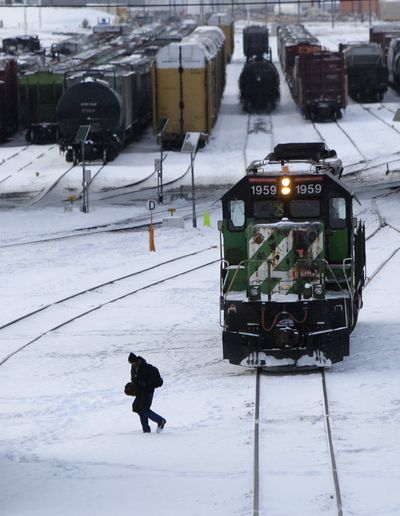Freight trains carrying 20 percent less cargo
Sharp drop in 2009 reflects recession

LOS ANGELES – The nation’s railroads had their worst year in decades in 2009, a dramatic reminder of the brutality with which the recession dampened demand for coal, lumber and other goods that make up the backbone of the economy.
Freight trains carried 20 percent less cargo last year than in 2008, according to a new report by the Association of American Railroads, and the industry shed nearly 21,000 jobs.
The 12-month period was the slowest since the association began keeping records in 1988.
Among the most dramatic declines was a 33 percent drop in lumber and wood products carried by train, a key indicator of demand for new construction. Trains carried 34 percent fewer motor vehicle parts and 8 percent less coal.
“Last year saw declines, most of them quite steep, in every major category of rail carload traffic,” said John Gray, senior vice president of policy and economics for the rail association. “Railroads are happy to have 2009 behind them.”
The drops in the movement of coal, lumber, retail goods and other products carried by train mirrored almost immediately the devastation in the U.S. economy wrought by the housing and mortgage industry meltdowns. As demand crashed for houses, cars and the commodities used in manufacturing, so did the need to haul goods and materials.
Taken over a two-year period that included all of 2008 and 2009, the declines were even more dramatic, according to the report: a 48 percent drop in the transportation of motor vehicle parts; a 49 percent drop in metallic ores and metals; and a 47 percent drop in wood products.
By last month, though, the picture was beginning to brighten. Twelve of the 19 main commodities hauled by trains – including grain, chemicals and petroleum and automobile parts – showed growth during December when compared to the same period a year earlier.
Several Wall Street analysts were predicting increased rail traffic in 2010 as the housing and automobile industries begin to recover, increasing demand for lumber and motor vehicle parts. Demand for coal could also increase as factories begin to ramp up production.
In November, billionaire investor Warren Buffett bet big on railroads, agreeing to pay $34 billion for the Burlington Northern Santa Fe Corp. The world’s second-richest man called the investment an “all-in wager on the economic future of the United States,” just a month before the industry began to show signs of recovery.
If the improvement continues, it would bring relief to the railroads, which were suffering before the economic slowdown spread to other countries from the United States, said Rick Paterson, a transportation analyst for UBS Investment Research in New York.
Analyzing freight movement since 1932, Paterson said last year was the third worst since the Great Depression, trailing only the recessions of 1938 and 1939.
Railroads like Fort Worth, Texas-based BNSF and Union Pacific, headquartered in Omaha, Neb., will be “in much better shape in 2010” as domestic freight and international trade recover, he said.